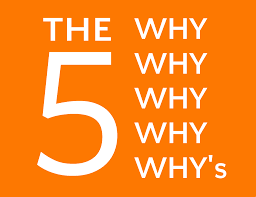With 15 years of experience in the edtech sector, I’ve seen great examples and things go wrong. This post is the first in a series, giving tips for your next edtech endeavour.
What I know about Edtech. #1 – The 5xWhys
I know that most edtech does not align the needs of learners with the purpose of those who make it.
The 5xWhys are one of the most valuable and well honed tools in my edtech toolbox. I use them at for researching, commissioning, building, and evaluating edtech projects and programmes. But they are most useful at the very beginning of thinking about edtech programmes / projects.
Why are you creating an edtech solution? To help raise standards and help teachers? That’s what you tell the world. But what are the real reasons?
There are far too many unsuccessful projects out there (including some of mine) where enthusiasm, bells & whistles, great content, etc, were not enough to see them over the line.
All too often, I think it is because those driving it fail to be honest, be clear and be open about why they are doing it.
Why does this matter? Because education is contested and challenging enough without more poorly built edtech filling the market. Children and teachers deserve better. It will also stop you wasting money and enable you to spend it on more of what matters!
Depending on the purpose of your organisation, (charity, awarding body, for-profit, or cultural institution) there are always strategic goals that edtech work can appear to be the answer to. I’ve read many briefs, specifications and project documents that read well, seem comprehensive, and get the ‘green light’ – but skirt around the most important question. Why do this?
Too often, organisations tell their development partners (those who are helping make this edtech a reality) that they want something that is going to be innovative; is going to change the education paradigm; to transform the perception of a subject; or to save teachers time. Though these goals are lofty and make for compelling copy, they are rarely the whole story.
What they really want is to drive more traffic to their website – or raise brand awareness – or stop their competition getting somewhere first. Or, most commonly, they have not really thought hard enough about it. It seemed like a good idea – and the logic of why to do it was added later. Without this key information driving the decision making, the design of edtech (and many aspects of work) can be flabby and lack clear focus.
In the creation of user stories and making hard development decisions a lack of honesty about what’s in it for the organisation making the edtech can fatally undermine all the hard work of the rest of the team.
I now use the 5xWhys to drill down past the fluff, and to get to the nitty gritty. If you haven’t see this approach in action, the simple example in the picture often helps clients ‘get it’.
Obviously, it is about framing and reframing the questions in a way to provoke deeper thinking, and not just asking ‘Why?’ repeatedly.
Here is an example from a recent client, who are a national arts organisation:
Why enter into education work?
To broaden reach.
Why broad reach (not narrow, local)?
Because we are a national organisation.
Why be national (instead of local)?
It is in our remit which we set ourselves.
Why did you make that remit?
Because that’s how the funding works.
Why go after the funding?
Because funding equals clout and respect which enables us to put (insert arts focus here) into the national conversation.
This conversation meant we could look at options that might increase the respect that they sought – rather than try to transform classroom practice or inform curriculum design.
So, how else might this work?
If you are commercial – you might see a funding opportunity or a failing in the competition to deliver an effective solution, where you can steal market share.
- If taking market share is your goal, then creating something really innovative is a poor choice. Instead, take the elements your competitor is doing, but do it better!
If you are a non-profit, it might be about raising awareness, engaging new stakeholders, or changing the terms of a debate.
- Teachers don’t need to spend money on a new edtech service to lean more about the work you do. Spend the money on a series of events that create ambassadors for your message.
If you are a museum, it might be about increasing footfall at a new exhibit, or gathering evidence for new funding or giving an education team meaningful work for when they are not taking school groups around.
- If you have an expert and enthusiastic team, instead of creating pdfs and videos that few will see – why not allow them to immerse themselves in to Social Media spaces and draw attention through authentic relationships.
Whatever the real reasons for creating edtech, how you engage with teachers, children, parents and those engaged in the business of formal education matters because if they waste time on something that isn’t as good as it could be, that is time taken from children.
So, if you really care about education, ask yourself why you want to be in it, and why your digital solution is really worth creating. If you have solid answers, then, proceed when ready! But, read the next few posts in this mini-series first.
If you’d like help with developing your edtech proposals, asking the 5xWhys or talking with the education sector; get in touch and let’s start a conversation.



Pingback: What I know about Edtech. #3 – Bikes without Wheels | Eylan Ezekiel
Pingback: Why? We need to Get Real | Eylan Ezekiel